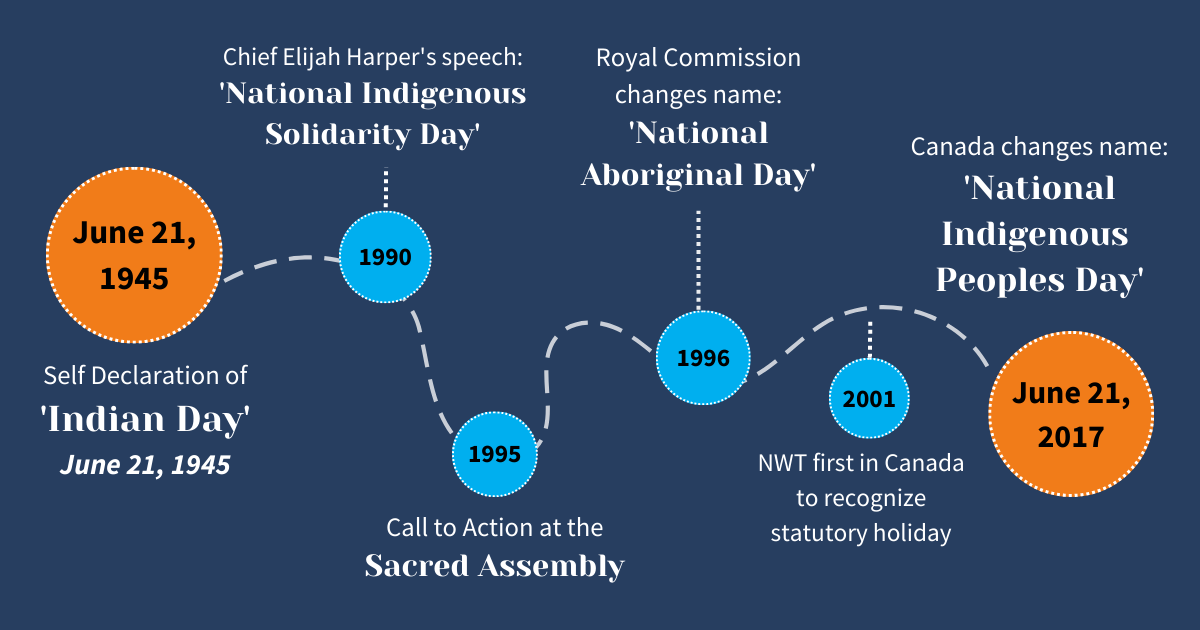The long and little-known history of National Indigenous Peoples Day

BY FRANK BUSCH
I remember feeling immense pride [as a 12 year old] at learning there was a special day on the calendar “just for us” as the previous decades had not been kind to Indigenous People.
At the end of the 2nd Great War, a visionary Indigenous leader (Wendat/Huron from Wendake, Quebec) by the name of Jules Sioui, unhappy with the way Indigenous soldiers were treated during the war, began to campaign for Indigenous Sovereignty. Sioui, along with Chiefs from across Turtle Island (North America) self-declared “Indian Day” on June 21, 1945. It was a call to action for Indigenous Peoples to unite and fight for recognition and respect from the colonial governments. This work led to the formation of the National Indian Brotherhood (now AFN) and other groups whose work led to the Indigenous governance systems we see in place today.
The day was remembered but occasionally forgotten throughout the years, communications not being what they are today. The mainstream news media didn’t care to mark the occasion for most of Canada’s post-war history. I myself first heard about it in 1990 (at the age of 12) from a speech given by the late Chief Elijah Harper, who called for the recognition of this special day, which he called “National Aboriginal Solidarity Day”. I remember feeling immense pride at learning there was a special day on the calendar “just for us” as the previous decades had not been kind to Indigenous People. The word “Aboriginal” was just coming into vogue, and was replacing the moniker “Native” which had begun to hold negative connotations.
Elijah repeated this call to action in 1995 at the “Sacred Assembly” which paved the way for the Indian Residential Schools Apology and the settlement agreement that followed. The way Elijah described it, we needed a day to unite as Indigenous people towards our common goals, putting aside the political infighting that has plagued “the cause” for generations. It was meant to be a day where Indigenous people reflected on how far we have come, how we have survived, and how far we still have to go to become self-reliant.
In 1996, the Royal Commission on Aboriginal People took up the call and recommended recognition of “National Aboriginal Day” changing the name to reduce the politically charged nature of the call for “solidarity”. It was later in 1996 that then Governor-General Romeo LeBlanc proclaimed it such, but it did not become a federal statutory holiday until much later.
In 2001, the Government of the Northwest Territories was the first to officially recognize it, and the other provinces and territories slowly followed suit. In 2017, Canada changed the name to “National Indigenous Peoples Day” and it is now a Federal Statutory Holiday.
Aside from some federal employees getting a day off work (which everyone else should one day enjoy), what can we do to mark the occasion? Whether you are Indigenous or not, the day should be spent celebrating (or at least reflecting on) the history of Canada, good and bad. It is only in the knowledge of where we have been can we determine where we are going, and more importantly, how we will get there.
At Strategies North, every day is a day to improve the Indigenous community, so our staff will be reflecting on how much we have accomplished in partnership with our community partners. If one is able, try to find an event in your local area to attend, even if only for an hour or two. You will certainly be welcome, and encouraged to purchase Indigenous food and artwork from local producers and artisans.
If there isn’t anything going on in your immediate vicinity, check out “Indigenous Day Live 2023” on APTN. The gang at APTN really go all out for June 21st every year and line up performances from established as well as emerging Indigenous musicians. Don’t forget to put on some sunscreen, you will be getting a lot more sun than any other day of the year!
What is National Indigenous Peoples Day?
While this is not a new day, it might be new to some people. If you have people in your life that are new to Canada or just starting to learn about Indigenous communities, below is an introduction that you might wish to share with them.
BY BRENNA BARLEY
National Indigenous Peoples Day provides an opportunity for Indigenous peoples across the country to come together to celebrate their unique traditions, languages, and cultures. It is also a chance for non-Indigenous people to learn more about the history and ongoing struggles of Indigenous peoples, and to show their support for reconciliation efforts.
One of the most important aspects of National Indigenous Peoples Day is the recognition of the resilience and strength of Indigenous communities in the face of centuries of colonization, forced assimilation, and systemic oppression. It is a day to honor the contributions of Indigenous peoples to Canada’s history, culture, and society, and to acknowledge the ongoing work that is needed to address the legacy of colonialism and promote healing and reconciliation.
Events and activities to mark National Indigenous Peoples Day take place across the country, from traditional pow wows and drumming circles to art exhibits, film screenings, and community feasts. Many Indigenous communities also use the day as an opportunity to share their stories and experiences with the wider public, and to educate others about their culture and traditions.
In recent years, there has been growing recognition of the need to center Indigenous voices and perspectives in discussions about Canada’s past, present, and future. National Indigenous Peoples Day is an important part of this ongoing effort, and a reminder of the vital role that Indigenous peoples play in shaping the country’s identity and future.